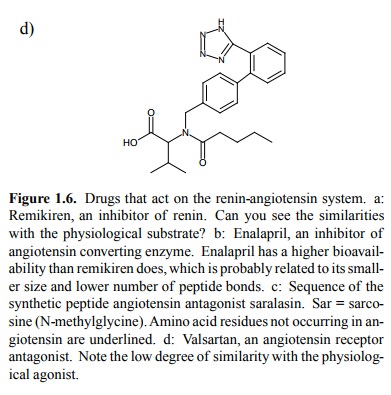Chapter: Biochemical Pharmacology : Introduction
Drug molecules may or may not have physiological counterparts
Drug molecules may or may not
have physiological counterparts
The vasoconstricting action
of angiotensin can also be countered at the membrane receptor directly. One
such inhibitor that has been around for quite a while is saralasin (Figure
1.6c).
Saralasin illustrates that
the structure of the physiological mediator or substrate is a logical starting
point for the syn-thesis of inhibitors. However, it is not a completely
satisfac-tory drug, because it cannot be orally applied – can you see why? The
more recently developed drug valsartan (Figure 1.6d) is orally applicable, but
has very limited similarity to the physiological agonist.


Enalapril and valsartan
represent the two practically most important functional groups of drugs,
respectively – en-zyme inhibitors, and hormone or neurotransmitter receptor
blockers. Another important group of drugs that act on hormone and neutotransmittor
receptors are `mimetic' or agonistic drugs. However, there is no clinically
useful ex-ample in the reninangiotensin pathway; we will see examples later.
Related Topics